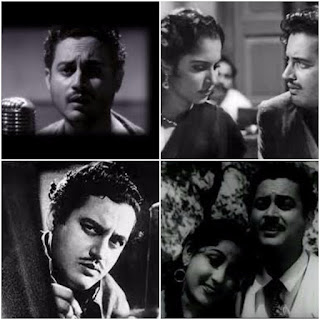Guru Dutt, a Sarswat Brahmin, was born on 9th July, 1925, in Bangalore to a middle class Couple Shri Shivashankar Padukone and Vasanthi Padukone. His parents moved to Calcutta when Guru Dutt was a small child.
Guru Dutt's creative uncle Shri B. B. Benegal had a great flair for art and music. Shri Benegal had a great influence on young Guru Dutt during his childhood days. Guru Dutt completed his Matriculation in 1941. However, due to financial constraints, he could not study any further. Guru Dutt had a great affinity towards Hindi and Bengali folk music. Guru Dutt had a natural inclination towards dancing and choreography. Shri Benegal provided Guru Dutt financial assistance to join Famous dancer Uday Shankars School of Dancing and Choreography at Almora near Nainitaal. After completing his dance training, Guru Dutt worked as a Telephone Operator in Calcutta for a short time. He left this job after a short stint and came to Mumbai to try his luck. In Mumbai, he started to organize his own dance compositions. He went to Pune and joined famous Prabhat Studios in Pune and started to work as choreographer. Along with choreography, Guru Dutt started assisting Hindi Film Directors which was his natural inclination.
Dev Anand, his close friend from Prabhat days had already started his own banner. During Prabhat days, Dev Anand had promised Guru Dutt that if he ever produced a film, he will give Guru Dutt a chance to direct and if Guru Dutt was to produce a film before Dev then Guru Dutt will cast Dev as a hero in his film. It so happened that Dev Anand was the first one to produce his film Baazi (1951) under his Navketan Banner and as promised, Dev Anand gave Guru Dutt a break to direct this film. This was Guru Dutts debut film as a director. With Guru Dutts able direction, Baazi, a crime thriller, was a huge success at the box office and became a trend setter for several crime thrillers those followed.
During the recording of the hit song Tadbir se bigdi huwi taqdeer bana de, Guru Dutt met the singer Geeta Roy. Their friendship soon blossomed into love and Guru Dutt married Geeta Roy on 26th May, 1953, at Geetas mothers home in Santacruz, Mumbai.
After the success of Baazi, Guru Dutt directed another crime thriller Jaal (1953). Director Guru Dutt was promoted to act as a hero in the next film Baaz (1953). But Baaz flopped miserably shaking the confidence of Guru Dutt to act as a leading man in the film. Guru Dutt then decided to launch his own company Guru Dutt Productions.
Guru Dutts breakthrough as actor-producer-director came with the film Aar Paar (1954). Guru Dutt then produced Mr. and Mrs. 55 (1955) which was a light hearted comedy with beautiful actress Madhubala as the heroine. Because of O. P Nayyars lilting tunes, Mr. and Mrs. 55 was a super hit.
By now Guru Dutt had claimed a big name for himself and also earned lots of money. And this was the precise moment Guru Dutt was waiting for. For last couple of years, Guru Dutt had in his mind to produce a highly emotional social film. The name of that film was Pyaasa (The Thirsty one) and it was a masterpiece. In Pyaasa, Guru Dutt extracted best from 4 actors: Rehman, Waheeda Rehman, Mala Sinha and Guru Dutt himself.
After the success of Pyaasa, Guru Dutt had bigger dreams. He wanted to produce yet another movie on a grand scale. And the film was Kaagaz Ke Phool, the first Cinemascope movie produced in India. In this movie, Guru Dutt actually depicted what he always feared in his real life and that was the possibility of becoming a failure. In this movie, Guru Dutt created some unforgettable visuals using ace cameraman V. K. Murthys still-admired photography.
After the bitter experience of Kagaz Ke Phool, Guru Dutt had not still given up. And in 1960, he produced a very successful movie Chaudhavi Ka Chand which was a Muslim Social. This film was a super hit and the film filled Guru Dutts coffers. Guru Dutt finally recovered all his earlier financial losses.
Every newspaper and film magazines in India carried the news of Guru Dutts suicide on the front pages. Kaifi Azmi wrote a poem in tribute to Guru Dutt that was featured in Filmfares cover article. The poem Rehne ko sadaa dehr mein aata nahin koyi, tum jaise gaye aise bhi jaata nahin koyi (No one comes to stay for ever, but no one leaves as you did), aptly voiced Kaifi Azmis sadness.
http://creative.sulekha.com/guru-dutt-maestro-director-and-his-death-mystery_364993_blog



No comments:
Post a Comment